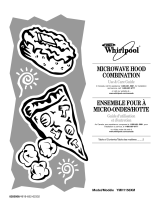
10
KEYPAD FEATURE INSTRUCTIONS
SOFTEN
MELT
Melt 1. Touch SOFTEN MELT.
2. Touch number keypad “1” to select Melt function.
OR
Touch SOFTEN MELT repeatedly to scan and select Melt.
3. Touch number keypad to select food type from the Melt Chart.
OR
Touch SOFTEN MELT repeatedly to scan and select food settings.
4. Touch number keypads to enter quantity (weight or sticks).
To change the doneness setting, touch the Power keypad before or after the “Start?” prompt
is displayed to toggle through and select a doneness of Normal, More, or Less.
5. Touch START.
The upper oven display will count down the melt time.
When the stop time is reached, the oven will shut off automatically and “Melt Complete”
will appear in the display.
If enabled, end-of-cycle tones will sound, and then reminder tones will sound every minute.
6. Touch CANCEL or open the door to clear the display and/or stop the reminder tones.
Display(s)
When power is first supplied to the oven, the timer display will
flash “12:00,” and “Clock-enter time” will appear on the display.
Enter the time by touching the number keypads. Then touch
START to allow operation. To allow operation without changing
the time, touch START or CANCEL.
Lower Oven Display (combination oven models)
When the lower oven is in use, this display shows the oven
temperature, heat source(s) and start time. In addition, during
Timed Cooking, this display shows a time countdown and the
stop time (if entered).
When the lower oven is not in use, this display shows the time
of day or time countdown.
Upper Microwave Oven Display (combination oven
models)
When the upper oven is in use, this display shows the upper
oven heat source(s), cooking power, quantities, weights, and/or
help prompts and time countdown.
When the upper oven is not in use, this display is blank.
Microwave Oven Display (single oven models)
When the microwave oven is in use, the display shows the
heat source(s), cooking power, quantities, weight, and/or help
prompts and time countdown.
Time of Day/Timer Display
When the microwave oven is not in use, the display shows
the time of day or time countdown.
Number Codes
The oven is preset with shortcut number codes. A number code
includes one or more of the following; food category, cooking
power, cook time, and food quantity or weight. See the code
charts in the “Reheating,” “Defrosting,” “Steam,” “Soften/Melt,”
and “EasyConvect™” sections for additional information.
Start/Add 1 Minute
The Start/Add 1 Minute keypad controls 2 separate functions
for the built-in microwave: Start and Add 1 minute.
Start
The Start/Add 1 Min keypad begins any upper or single oven
cooking function once enough data has been entered and the
door is closed.
After enough data has been entered and the door is closed,
“Start?” will appear on the oven display as a reminder. If the
Start keypad is not touched within 5 minutes after touching
another keypad, the oven display will return to the inactive
mode and the programmed function will be canceled.
If cooking is interrupted by opening the door, touching Start/
Add 1 Minute after the door is closed again will resume the
preset cycle.
Add 1 Minute
Touching Start/Add 1 Minute when the microwave oven is off
will start 1 minute of cook time at 100% power. To use this
feature the display must be in the time of day visualization, and
the lower oven must be off (combination models only). Touching
Start/Add 1 Minute while the microwave oven is operating
will add cook time to the current cycle by 1 minute. Multiple
minutes can be added by repeatedly touching Start/Add 1
Minute.
Control Lock
NOTE: On microwave ovens, the Control lock is locked or
unlocked by touching the “Cancel” key pad. On combination
ovens, the Control lock is locked or unlocked by touching the
lower oven “Start” keypad.
The Control Lock shuts down the control panel keypads to
avoid unintended use of the oven. The Control Lock will remain
set after a power failure, if set before the power failure occurs.
When the control is locked, only the Set/Start, Oven Light, and
Timer Set/Off keypads will function.
The Control Lock is preset unlocked, but can be locked.
To Lock Control: Touch and hold lower oven START (on
combination ovens only) or Cancel (on microwave ovens only)
for approximately 3 seconds, until “Control Locked” appears on
the lower text line and a lock icon appears in the display.
To Unlock Control: Repeat to unlock. “Control Unlocked”
appears on the lower text line and the lock icon will be
removed.




















